History
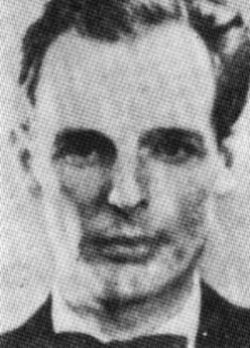 Donald Maclean and Guy Burgess were senior officials in the British Foreign Office and in 1951. They were trusted diplomats, but they had a dark side. They were well known to have left-leaning ideas, and eventually their ideas moved them so far out of line with the jobs they had that it was suspected, if not known that they had become spies for the Soviet Union. Maclean and Burgess were two of the original members of the notorious Cambridge Spy Ring, which was a ring of spies in the United Kingdom, who passed information to the Soviet Union during World War II. They were active at least into the early 1950s. Four members of the ring were originally identified: Kim Philby (cryptonym: Stanley), Donald Duart Maclean (cryptonym: Homer), Guy Burgess (cryptonym: Hicks) and Anthony Blunt (cryptonyms: Tony, Johnson). Once jointly known as the Cambridge Four and later as the Cambridge Five, the number increased as more evidence came to light.
Donald Maclean and Guy Burgess were senior officials in the British Foreign Office and in 1951. They were trusted diplomats, but they had a dark side. They were well known to have left-leaning ideas, and eventually their ideas moved them so far out of line with the jobs they had that it was suspected, if not known that they had become spies for the Soviet Union. Maclean and Burgess were two of the original members of the notorious Cambridge Spy Ring, which was a ring of spies in the United Kingdom, who passed information to the Soviet Union during World War II. They were active at least into the early 1950s. Four members of the ring were originally identified: Kim Philby (cryptonym: Stanley), Donald Duart Maclean (cryptonym: Homer), Guy Burgess (cryptonym: Hicks) and Anthony Blunt (cryptonyms: Tony, Johnson). Once jointly known as the Cambridge Four and later as the Cambridge Five, the number increased as more evidence came to light.
The group was recruited during their education at the University of Cambridge in the 1930s…hence the term Cambridge. There is much debate as to the exact timing of their recruitment by Soviet intelligence. Anthony Blunt claimed that they were not recruited as agents until they had graduated. Blunt, an Honorary Fellow of Trinity College, was several years older than Burgess, Maclean, and Philby; he acted as a talent-spotter and recruiter for most of the group save Burgess. Several people have been suspected of being additional members of the group; John Cairncross (cryptonym: Liszt) was identified as such by Oleg Gordievsky, although many others have also been accused of membership in the Cambridge ring. Both Blunt and Burgess were members of the Cambridge Apostles, an exclusive and prestigious society based at Trinity and King’s Colleges. Cairncross was also an Apostle. Other Apostles accused of having spied for the Soviets include Michael Whitney Straight and Guy Liddell.
The group was radical in their dealings, so I’m not sure that anyone was overly surprised when both Maclean and Burgess disappeared from England in 1951, although they may have assumed that they were assassinated. For years there was no trace of them, and I suppose people began to forget all about them. Nevertheless, there were rumors that they had been spies for the Soviet Union and had left England to avoid prosecution. For five years, nothing was heard of the pair. British intelligence suspected that they were in the Soviet Union, but Russian officials consistently denied any knowledge of their whereabouts.
Then, on February 11, 1956, the pair resurfaced and invited a group of journalists to a hotel room in Moscow. Burgess and Maclean were there to greet them, give a brief interview, and hand out a typed joint statement. In the statement, both men denied having served as Soviet spies. However, they very strongly declared their sympathy with the Soviet Union and stated that they had both been “increasingly alarmed by the post-war character of Anglo-American policy.” They claimed that the decision to leave England and live in Russia was due to their belief that only in Russia would there be “some chance of putting into practice in some form the convictions they had always had.” They were convinced that the Soviet Union desired a policy of “mutual understanding” with the West, but many officials in the United States and Great Britain were adamant in 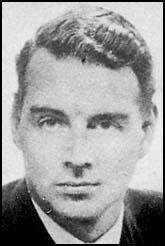 their opposition to any working relationship with the Russians. They concluded by stating, “Our life in the Soviet Union convinced us we took at the time the correct decision.”
their opposition to any working relationship with the Russians. They concluded by stating, “Our life in the Soviet Union convinced us we took at the time the correct decision.”
While the surprise news conference solved the mystery of where Burgess and Maclean had been for the past five years, it did little to settle the question of why they had gone to the Soviet Union in the first place. Their statement also did not clear up the issue of whether or not they had spied for the Soviet Union. Evidence from both British and American intelligence agencies strongly suggested that the two, together with fellow Foreign Office workers Kim Philby and Sir Anthony Blunt, had engaged in espionage for the Russians. Both men spent the rest of their lives in the Soviet Union. Burgess died in 1963 and Maclean passed away in 1983. I don’t suppose we will ever know all of the British and possibly American secrets they shared with the Russians during those years, only that they were treasonous traitors.
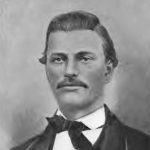 The move west to settle America was seldom a peaceful move. These days we think of loading up our car, and moving to a new city…done and easy, but it wasn’t so back then. There were outlaws, Indians, and unknown perils that could end a trip west, almost before it got started. There were a number of trails commonly used to get to the gold fields in the west, but the Bozeman Trail was one of the most violent, quarrelsome, and ultimately failed experiments in American frontier history. The trail was named for John Bozeman, an emigrant from Georgia, who was said to have blazed the route, but in actuality, the Indians had been using the route as a travel corridor for centuries. Nevertheless, John Bozeman did play a part in the trail. In 1863, Bozeman and partner, John Jacobs widened this corridor for use as a wagon road. They were following in much the same footsteps as Captain William Raynolds had four years earlier in a mapping and exploration expedition for the Army Corps of Topographic Engineers. The plan was to make the trail a shortcut to the goldfields in and around Virginia City, Montana territory. The Bozeman route split off of the Oregon Trail in central Wyoming. Then it skirted the Bighorn Mountains, crossed several rivers including the Bighorn, then traversed mountainous terrain into western Montana. The trail follows a very similar route to the current roads that meander through Wyoming today. The Bozeman trail had several advantages, including an abundant supply of water along with the most direct route to the goldfields, making it the go to trail of that era.
The move west to settle America was seldom a peaceful move. These days we think of loading up our car, and moving to a new city…done and easy, but it wasn’t so back then. There were outlaws, Indians, and unknown perils that could end a trip west, almost before it got started. There were a number of trails commonly used to get to the gold fields in the west, but the Bozeman Trail was one of the most violent, quarrelsome, and ultimately failed experiments in American frontier history. The trail was named for John Bozeman, an emigrant from Georgia, who was said to have blazed the route, but in actuality, the Indians had been using the route as a travel corridor for centuries. Nevertheless, John Bozeman did play a part in the trail. In 1863, Bozeman and partner, John Jacobs widened this corridor for use as a wagon road. They were following in much the same footsteps as Captain William Raynolds had four years earlier in a mapping and exploration expedition for the Army Corps of Topographic Engineers. The plan was to make the trail a shortcut to the goldfields in and around Virginia City, Montana territory. The Bozeman route split off of the Oregon Trail in central Wyoming. Then it skirted the Bighorn Mountains, crossed several rivers including the Bighorn, then traversed mountainous terrain into western Montana. The trail follows a very similar route to the current roads that meander through Wyoming today. The Bozeman trail had several advantages, including an abundant supply of water along with the most direct route to the goldfields, making it the go to trail of that era.
Still, the trail had one major drawback. It cut through the heart of territory that had been promised to several Indian tribes by the Treaty of Fort Laramie in 1848, making the people traveling the trail…the outlaws. The area included the rich hunting grounds of the Powder River Country, claimed by the Sioux and other tribes. They were not feeling very hospitable about these “white men” traipsing through their hunting grounds, killing their animals, and running off many in the herds. Nevertheless, the first emigrant trains began traveling up the trail not long after Bozeman and Jacobs had finished marking the route. In 1864, a large train of 2,000 settlers  successfully made the trek. This was the high point of travel along the corridor. Though some wagon trains were successful after that, there were constant threats of attack. Over the next two years travel along the corridor came to a complete halt because of numerous raids by a coalition of tribes.
successfully made the trek. This was the high point of travel along the corridor. Though some wagon trains were successful after that, there were constant threats of attack. Over the next two years travel along the corridor came to a complete halt because of numerous raids by a coalition of tribes.
Then the people started to put pressure on the United States government to protect the travelers. In 1866, United States Army troops were dispatched to construct three forts along the trail, which would supposedly offer protection to wagon trains. These posts, running from south to north, were Forts Reno, Phil Kearny and C.F. Smith. Ominously, each of these forts was named after a general that had died during the just completed Civil War. Somehow that doesn’t seem to instill a lot of hope…at least to me. With the installation of the forts, the trail had, in effect become a military road. The protection afforded by the United States Army presence enraged the tribes. With that intervention came a two year conflict, known as Red Cloud’s War. Under the leadership of Oglala Lakota chief Red Cloud, raids and ambushes were carried out against soldiers, civilians, supply trains and anyone else who dared to attempt the trail.
Three famous skirmishes were The Fetterman Massacre, in December, 1866, in which an army detachment of 79 soldiers and 2 civilians led by Captain William Fetterman were lured from Fort Phil Kearney and ambushed within a few miles of the fort. On August 1, 1867, the Hayfield Fight, where 19 soldiers and 6 civilians detailed for guard and hay cutting duty were attacked. The Indians held them under siege for over 8 hours, but they managed to hold off 500 hundred warriors until help arrived. And finally, The Wagon Box Fight, where a detachment of 31 soldiers sent out to guard a team of wood cutters, was encircled. They fought off numerous attacks over a five hour period from hundreds of warriors. These continued raids and skirmishes were the rule that proved that peace was not going to be the reality they had hoped. Life guarding the trail was a 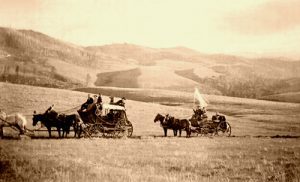 combination of tension, monotony, and loneliness. Soldiers on the verge of mutiny and even cases of insanity, deserted their posts. With few, if any, emigrants using the trail, because they were too afraid, the army sequestered behind fortress walls and tribes showing few signs of easing up on attacks. Finally, the United States government decided to pursue a peace policy. The second (1868) Fort Laramie Treaty recognized the Powder River Country once again as the hunting territory of the Lakota and their allies. A presidential proclamation was issued to abandon the forts. The Bozeman Trail was history, and for the first time, the United States government had lost a war. What a shock that must have been for our nation.
combination of tension, monotony, and loneliness. Soldiers on the verge of mutiny and even cases of insanity, deserted their posts. With few, if any, emigrants using the trail, because they were too afraid, the army sequestered behind fortress walls and tribes showing few signs of easing up on attacks. Finally, the United States government decided to pursue a peace policy. The second (1868) Fort Laramie Treaty recognized the Powder River Country once again as the hunting territory of the Lakota and their allies. A presidential proclamation was issued to abandon the forts. The Bozeman Trail was history, and for the first time, the United States government had lost a war. What a shock that must have been for our nation.
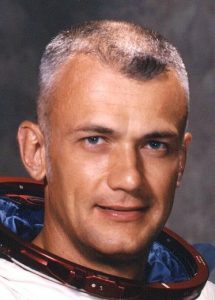 These days, lots of people have used hang-gliders, or squirrel suits, or parachutes to be able to “fly” without the use of an airplane, and lots of people absolutely love the rush they get from it. I suppose it would be very cool, but the clear fact is that, in reality, you are performing a fall of sorts, with a landing definitely in the future. There is no ability to go back up with the equipment you have.
These days, lots of people have used hang-gliders, or squirrel suits, or parachutes to be able to “fly” without the use of an airplane, and lots of people absolutely love the rush they get from it. I suppose it would be very cool, but the clear fact is that, in reality, you are performing a fall of sorts, with a landing definitely in the future. There is no ability to go back up with the equipment you have.
I guess that makes the flight that Captain Bruce McCandless II took on February 7, 1984 very unique. McCandless was a NASA astronaut aboard the space shuttle Challenger, as a mission specialist on STS-41B (February 3-11, 1984), when he became the first human to fly in space…untethered. This is not a falling situation. In fact, had he not initiated the jet packs power to maneuver his way back to the shuttle, he could have floated around in space forever. Of course, he did not choose to do that, and so after 5 hours and 55 minutes, McCandless maneuvered the bulky white rocket pack, of his own design, back to the space shuttle. I think that deep down inside him, he must have thought, “No!!! I don’t want it to be over yet!!” The feeling of exhilaration over what he had accomplished, must have give him the ultimate adrenalin rush!! A rush like no one else had ever felt before. McCandless orbited the Earth in tangent with the shuttle at speeds greater than 17,500 miles per hour and flew up to 320 feet away from the Challenger. Then, after an hour and a half testing and flying the jet-powered backpack and admiring Earth, McCandless safely reentered the shuttle.
Later that day, Army Lieutenant Colonel Robert Stewart tried out the rocket pack, which was a device regarded as an important step toward future operations to repair and service orbiting satellites and to assemble and  maintain large space stations. It was the fourth orbital mission of the space shuttle Challenger. His untethered space walk lasted 6 hours and 17 minutes. The rocket pack worked beautifully. It was a great advancement, but my mind goes back to the man. How did he feel when he took that first step out into space, knowing that if this didn’t go as planned, he could be lost in space forever? Then, he took a leap of faith, and stepped out. It must have been exhilarating and terrifying at the same time. Then when he realized that he could make the rocket pack do what he wanted it to, he must have been elated. What a rush that must have been, and for just a little while, he was alone…not only in space, but in that fact that he was the only one who had been there without being tied to a shuttle for safety. How amazing that must have been.
maintain large space stations. It was the fourth orbital mission of the space shuttle Challenger. His untethered space walk lasted 6 hours and 17 minutes. The rocket pack worked beautifully. It was a great advancement, but my mind goes back to the man. How did he feel when he took that first step out into space, knowing that if this didn’t go as planned, he could be lost in space forever? Then, he took a leap of faith, and stepped out. It must have been exhilarating and terrifying at the same time. Then when he realized that he could make the rocket pack do what he wanted it to, he must have been elated. What a rush that must have been, and for just a little while, he was alone…not only in space, but in that fact that he was the only one who had been there without being tied to a shuttle for safety. How amazing that must have been.
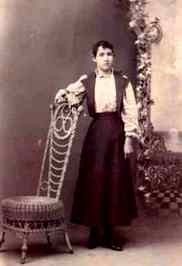 Myra Belle Shirley was born in a log cabin near Carthage, Missouri on February 5, 1848 to “Judge” John Shirley, and his third wife, Elizabeth “Eliza” Pennington. John Shirley was the black sheep of a well-to-do Virginia family who had moved west to Indiana, where he married and divorced twice. His third wife, Eliza, was on the Hatfield side of the feuding Hatfield and McCoy families, which ranks up there with people I wouldn’t want for parents. The Hatfield and McCoy feuds, while not starting until about 1865, went on for decades, and they were messy and confusing over those years. You might no know who Myra Belle Shirley was, or you might know her best at Belle Starr.
Myra Belle Shirley was born in a log cabin near Carthage, Missouri on February 5, 1848 to “Judge” John Shirley, and his third wife, Elizabeth “Eliza” Pennington. John Shirley was the black sheep of a well-to-do Virginia family who had moved west to Indiana, where he married and divorced twice. His third wife, Eliza, was on the Hatfield side of the feuding Hatfield and McCoy families, which ranks up there with people I wouldn’t want for parents. The Hatfield and McCoy feuds, while not starting until about 1865, went on for decades, and they were messy and confusing over those years. You might no know who Myra Belle Shirley was, or you might know her best at Belle Starr.
Myra grew up in a well to do family, after her father John Shirley made good in 1856 when he and his wife sold their financially successful farming venture raising wheat, corn, hogs, and horses in Jasper County, Missouri. When John sold the land, they opened an inn, a tavern, livery stable and blacksmith shop. Their businesses took up almost an entire city block. John Shirley had become a respected member of the burgeoning county seat of Carthage, and his daughter Myra Belle lived the life of a spoiled, rich girl, attending the Carthage Female Academy, where in addition to the basics, she was taught music and classical languages. She was a bright student, with polite manners, and a talent for playing the piano. However, she also liked to flaunt her status a “rich girl” and liked having an audience. She also loved the outdoors, where she spent many a day roaming the countryside with her older brother Bud, who taught her how to ride a horse and handle a gun…a little out of the ordinary, but still within the confines of a proper upbringing, but dramatic changes were coming for Myra.
When the Kansas-Missouri Border War broke out. Jasper County watched both armies pass through time and again, forcing residents to take sides, and making neighbors into bitter enemies. Irregular bands of “Jayhawkers” and “Red Legs” laid waste to Missouri communities in support of the Union. When son Bud joined Quantrill’s Raiders, John Shirley was a proud father. Bud, who knew the area and the people well, served admirably as a scout, quickly attaining a captain’s rank. But in June 1864 Bud was killed in Sarcoxie, Missouri. The raids had taken their toll on Shirley’s businesses and after Bud’s death, the “Judge” gave up, sold his Missouri property and moved his family to a farm near Scyene, Texas, a small settlement southeast of Dallas.
In 1866 the James-Younger Gang robbed their first bank in Liberty, Missouri, and fled with $6,000 in cash and bonds. Splitting up, Jesse and Frank James, along with the Youngers, fled to Texas, where they met up with Myra Shirley. Soon, Myra became smitten by Cole, quickly becoming a member of their “gang.” One of these outlaw bands, seeking refuge, stayed at the Shirley house one night. Belle later stated that it was there that she became reacquainted with the first man she ever loved. His name was Jim Reed, and she had first met him back in Missouri, where the Reed and Shirley families had been friends. The romance blossomed in Texas, and Belle and Jim married on November 1, 1866. The Shirleys had no objection to the marriage, as Jim Reed was not yet a wanted man. Jim moved into the Shirley household near Scyene and shared the farm chores. Later, he became a salesman for a Dallas saddle and bridle maker. By late 1867, though, he and Belle were living on the Reed homestead in Missouri. Early in September 1868, Belle gave birth to her first child, Rosie Lee. Belle adored the baby and referred to her as her “Pearl.” The nickname stuck. When Jim and Belle moved to Missouri, Reed was a wanted man, allegedly for murdering a man named Shannon. The two fled to California with their young daughter Pearl and before long a second child came along who they named Edward.
In 1869 Belle, Reed and two other outlaws rode to the North Canadian river country, where they tortured an old Creek Indian until he told them where he had hidden $30,000 in gold. With their share of the loot, Jim and Belle returned to Texas, where she played the role of “Bandit Queen” to the hilt. But, it wasn’t long before the outlaw life caught up with Reed and on August 1874, Reed was killed in a gunfight by a member of his own gang. Belle left her children with her mother while she rode the outlaw trail. In Indian Territory (what is now Oklahoma,) Starr got involved with a flat-faced Indian outlaw who went by the name of “Blue Duck.” Of her life, Belle Starr stated to The Fort Smith Elevator about one year prior to her death, “I regard myself as a woman who has seen much of life.” On February 3, 1889, two days before her 41st birthday, she was killed. She was riding home from a neighbor’s house in Eufaula, Oklahoma, when she was ambushed. After she fell off her horse, she was shot again to make sure she was dead. Her death resulted from shotgun wounds to the 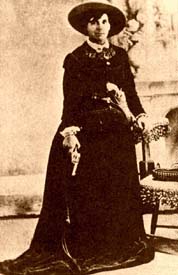 back and neck and in the shoulder and face. Legend says she was shot with her own double barrel shotgun. According to Frank “Pistol Pete” Eaton, her death was due to different circumstances. She had been attending a dance. Frank Eaton had been the last person to dance with Belle Starr when Edgar Watson, clearly intoxicated had asked to dance with her. When Belle Starr declined, he later followed her. When on the way home, she stopped to give her horse a drink at a creek, he shot and killed her. According to Frank Eaton, Watson was tried, convicted and executed by hanging for the murder.
back and neck and in the shoulder and face. Legend says she was shot with her own double barrel shotgun. According to Frank “Pistol Pete” Eaton, her death was due to different circumstances. She had been attending a dance. Frank Eaton had been the last person to dance with Belle Starr when Edgar Watson, clearly intoxicated had asked to dance with her. When Belle Starr declined, he later followed her. When on the way home, she stopped to give her horse a drink at a creek, he shot and killed her. According to Frank Eaton, Watson was tried, convicted and executed by hanging for the murder.
Belle’s children didn’t do much better, and turned out as one would expect, with the influence their mother had on them. Belle’s son, Eddie Reed, was convicted of horse theft and receiving stolen property in July 1889. Judge Parker sent him to prison in Columbus, Ohio. Belle’s daughter, Rosie Reed, also known as Pearl Starr, became a prostitute to raise funds for Eddie’s release. She did eventually obtain a presidential pardon in 1893. Ironically, Eddie became a deputy in Fort Smith and killed two outlaw brothers named Crittenden in 1895, and was himself killed in a saloon in Claremore, Oklahoma on December 14, 1896. Pearl operated several brothels in Van Buren and Fort Smith, Arkansas, from the 1890s to World War I.

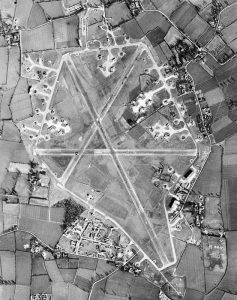 Most of the time, when we think of time and distance here on planet earth, we tend to feel like we are just a speck compared to the size of this planet, and I suppose that is true, but sometimes, our connection to one another is, in reality, much closer than we know. My dad, Allen L “Al” Spencer was a top turret gunner on a B-17G Bomber in World War II. He was stationed at Great Ashfield, Suffolk, England. I have always been very proud of my dad’s service, and because of his service, I have also always had an interest in other World War II bases in England.
Most of the time, when we think of time and distance here on planet earth, we tend to feel like we are just a speck compared to the size of this planet, and I suppose that is true, but sometimes, our connection to one another is, in reality, much closer than we know. My dad, Allen L “Al” Spencer was a top turret gunner on a B-17G Bomber in World War II. He was stationed at Great Ashfield, Suffolk, England. I have always been very proud of my dad’s service, and because of his service, I have also always had an interest in other World War II bases in England.
Yesterday, while researching my husband Bob’s great uncle, Richard F “Frank” Knox for his birthday today, I found myself reading his obituary again, looking for more information on a man I admired. I have always liked Frank very much, but because of the fact that we lived in Wyoming and they lived in Washington, I can’t say that I knew about his everyday life, and I certainly didn’t know about his military career. That said, while I had read the obituary right after his passing July 13, 2017, somehow it didn’t 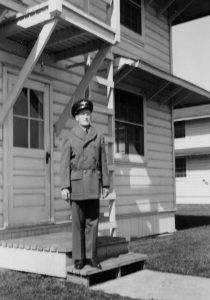 hit me that he was stationed as a communications officer at RAF Horham, Suffolk, England. Of course, my curious mind had to go to Google Earth. I wanted to know if the Air Base was still visible, because most of them have been in one way or another returned to farm land. I did find the base, and while it’s outline isn’t as clearly marked as Great Ashfield is, I could pick out RAF Horham too. After finding the base, I was able to imagine a young Uncle Frank living and working there during the war. To me, that thought was very interesting, but another thing I noticed was the fact that Horham was not that far from Great Ashfield. In fact, my dad and Bob’s Uncle Frank were stationed a mere 22 miles away from each other. It is doubtful that they ever met, and if they did, they probably wouldn’t remember it, because it would be just in passing, but it occurs to me now, that the two men have probably met in Heaven, and they probably had some interesting stories to tell about their time in England.
hit me that he was stationed as a communications officer at RAF Horham, Suffolk, England. Of course, my curious mind had to go to Google Earth. I wanted to know if the Air Base was still visible, because most of them have been in one way or another returned to farm land. I did find the base, and while it’s outline isn’t as clearly marked as Great Ashfield is, I could pick out RAF Horham too. After finding the base, I was able to imagine a young Uncle Frank living and working there during the war. To me, that thought was very interesting, but another thing I noticed was the fact that Horham was not that far from Great Ashfield. In fact, my dad and Bob’s Uncle Frank were stationed a mere 22 miles away from each other. It is doubtful that they ever met, and if they did, they probably wouldn’t remember it, because it would be just in passing, but it occurs to me now, that the two men have probably met in Heaven, and they probably had some interesting stories to tell about their time in England.
As big as this old world is, and as unlikely as it seems that two families could have some close connections like this, I find that at least in my life, and my husband’s life, there are some connections, some very near misses, and some interesting encounters. Like my dad, Uncle Frank served out his time in the Army Air Forces right there 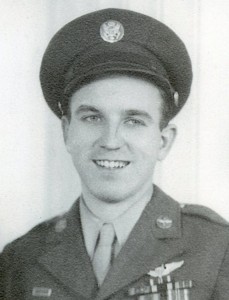
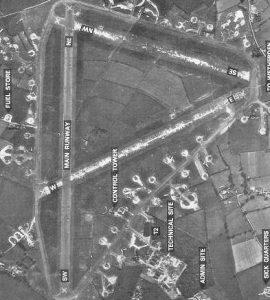 at RAF Horham, Suffolk, England. I imagine that like my dad, Frank took at least one leave to go and see London, because how could you go to England and not see London. Frank had a successful career in communications and then after his discharge from the service, four years, four months and four days of active duty, separating at war’s end with the rank of major. Frank served with distinction, earning a Bronze Star and the Air Medal, then he continued his military career in the Air Force Reserve. He retired in 1968 with the rank of Lieutenant Colonel. Today would have been Uncle Frank’s 98th birthday, and it is his first in Heaven. Happy birthday in Heaven, Uncle Frank. We love and miss you very much.
at RAF Horham, Suffolk, England. I imagine that like my dad, Frank took at least one leave to go and see London, because how could you go to England and not see London. Frank had a successful career in communications and then after his discharge from the service, four years, four months and four days of active duty, separating at war’s end with the rank of major. Frank served with distinction, earning a Bronze Star and the Air Medal, then he continued his military career in the Air Force Reserve. He retired in 1968 with the rank of Lieutenant Colonel. Today would have been Uncle Frank’s 98th birthday, and it is his first in Heaven. Happy birthday in Heaven, Uncle Frank. We love and miss you very much.
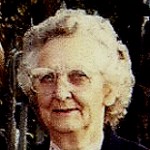 Many people say they would hate to be born on a holiday, and for the most part I think I agree, but while it isn’t really a “holiday,” Groundhog Day, for my husband’s grandmother, Vina Hein, was a special day. When she was born on February 2, 1909, Groundhog Day in the United States was a mere 22 years old. There are lots of differing views on how it came to be, but apparently, it is pretty much an American tradition. It is thought to be a spinoff, of sorts, of a tradition that started with the early Christians in Europe, and for centuries the custom was to have the clergy bless candles and distribute them to the people. Even then, it marked a milestone in the winter and the weather that day was important. On old song about the day went thus: If Candlemas be fair and bright, Come, Winter, have another flight; If Candlemas brings clouds and
Many people say they would hate to be born on a holiday, and for the most part I think I agree, but while it isn’t really a “holiday,” Groundhog Day, for my husband’s grandmother, Vina Hein, was a special day. When she was born on February 2, 1909, Groundhog Day in the United States was a mere 22 years old. There are lots of differing views on how it came to be, but apparently, it is pretty much an American tradition. It is thought to be a spinoff, of sorts, of a tradition that started with the early Christians in Europe, and for centuries the custom was to have the clergy bless candles and distribute them to the people. Even then, it marked a milestone in the winter and the weather that day was important. On old song about the day went thus: If Candlemas be fair and bright, Come, Winter, have another flight; If Candlemas brings clouds and 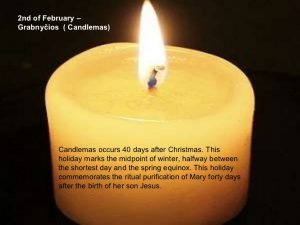 rain, Go Winter, and come not again. It all sounds quite familiar doesn’t it? Of course in the Christian religion, it meant something else. It is half way through winter, and it was also thought to be when Mary’s purification day occurred after Jesus was born.
rain, Go Winter, and come not again. It all sounds quite familiar doesn’t it? Of course in the Christian religion, it meant something else. It is half way through winter, and it was also thought to be when Mary’s purification day occurred after Jesus was born.
Nevertheless, leave it to Americans to make their warm weather travel plans based on the machinations of a reticent rodent. Each year, groundhogs around the country…but most notably Punxsutawney Phil of Punxsutawney, Pennsylvania, are paraded out to predict how many more weeks will transpire before spring is on the way. It’s either six more weeks of winter…as was the case with Punxsutawney Phil this year, or an early spring. It all depends upon  whether the groundhog sees his shadow or not. This tradition has been going on since 1887s, despite modest advances in weather prediction since that time…if you think the weatherman knows his business that is.
whether the groundhog sees his shadow or not. This tradition has been going on since 1887s, despite modest advances in weather prediction since that time…if you think the weatherman knows his business that is.
So, while it was not a major holiday, Grandma Hein’s birthday always had an added little bit of sparkle. If her wish came true, the groundhog would predict an early spring, because after all, who isn’t ready for the beautiful flowers of spring in the dead of winter. Today would have been Grandma Hein’s 109th birthday if she were still here. Grandma, I know that where you are, the Spring flowers are always blooming. Happy birthday in Heaven Grandma. We love and miss you very much.
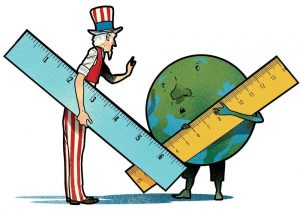 The metric system…in many ways, a source of contention between the American government, or whoever it is who keeps trying to push it on the American public, and the American public in general. Sure, it’s mixed in with our way of life, but somehow, it’s not something that most of us really understand very well. It’s like a strange foreign language, that no one wanted to learn in the first place…but somebody told us that it was important, better, more efficient…or some other such nonsense. It’s perfectly acceptable to use the metric system in the United States…in fact, Congress originally authorized its use in 1866 and has repeatedly tried to make it accepted in the years since, but the American public has continued to reject it.
The metric system…in many ways, a source of contention between the American government, or whoever it is who keeps trying to push it on the American public, and the American public in general. Sure, it’s mixed in with our way of life, but somehow, it’s not something that most of us really understand very well. It’s like a strange foreign language, that no one wanted to learn in the first place…but somebody told us that it was important, better, more efficient…or some other such nonsense. It’s perfectly acceptable to use the metric system in the United States…in fact, Congress originally authorized its use in 1866 and has repeatedly tried to make it accepted in the years since, but the American public has continued to reject it.
Although the government now requires metric use in some public sectors and strongly encourages it in many  private industries, but the American public never really took to the system and largely dismissed it, making the United States the only industrialized nation where that’s the case. These days the medical field exclusively uses it in their jobs, but when a nurse takes your temperature and tells you that it is 38° C, and you ask her how much that is in “English,” most of them have no idea that it is 101° F. Yes, they know that you are running a fever, but seriously, when you are running a fever, do you want to have to get out your nearest conversion table to figure out how high it is. Most of us know that normal is 98.6° F, but when you don’t feel good, the last thing you want to do is math. I don’t know who came up with inches and centimeters, or Celsius and Fahrenheit battle, but up until 1866, the United States knew what their measurements meant. We didn’t have to try to sit down and figure it all out. Why should we have to now? In American, it just doesn’t measure up.
private industries, but the American public never really took to the system and largely dismissed it, making the United States the only industrialized nation where that’s the case. These days the medical field exclusively uses it in their jobs, but when a nurse takes your temperature and tells you that it is 38° C, and you ask her how much that is in “English,” most of them have no idea that it is 101° F. Yes, they know that you are running a fever, but seriously, when you are running a fever, do you want to have to get out your nearest conversion table to figure out how high it is. Most of us know that normal is 98.6° F, but when you don’t feel good, the last thing you want to do is math. I don’t know who came up with inches and centimeters, or Celsius and Fahrenheit battle, but up until 1866, the United States knew what their measurements meant. We didn’t have to try to sit down and figure it all out. Why should we have to now? In American, it just doesn’t measure up.
So, in the next act of “pushiness,” Congress even passed a Metric Conversion Act of 1975 and set up a U.S.  Metric Board to take care of all the planning for the desired transition, but they apparently didn’t empower the board with enough authority, and the American people essentially said, “no” to adopting metric system, and continued on with their miles, pounds, ounces and all the rest. Similarly lackluster efforts since then have done little to get Americans to change their minds. We are a stubborn people, and we don’t really like it when someone tells us that, what we have always known as white, is now black. That simply makes no sense, and just because Congress tells us that it does, doesn’t mean that it is so. I don’t suppose that the failed metric conversion will be the last thing that Congress tries to push on us, that will end up in the junk heap…do you?
Metric Board to take care of all the planning for the desired transition, but they apparently didn’t empower the board with enough authority, and the American people essentially said, “no” to adopting metric system, and continued on with their miles, pounds, ounces and all the rest. Similarly lackluster efforts since then have done little to get Americans to change their minds. We are a stubborn people, and we don’t really like it when someone tells us that, what we have always known as white, is now black. That simply makes no sense, and just because Congress tells us that it does, doesn’t mean that it is so. I don’t suppose that the failed metric conversion will be the last thing that Congress tries to push on us, that will end up in the junk heap…do you?
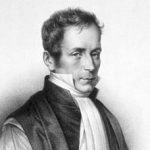 Whenever we make a trip to the emergency room, most of us find ourselves waiting impatiently for the myriad of tests to be returned from the lab to find out what is going on. And, most of us find that annoying, but when you think about how things used to be diagnosed, you might just find yourself rethinking those tests. Imagine a time when something like Pneumonia, Bronchitis, or Tuberculosis might have been “diagnosed” by having you doctor place his ear to your chest to see what you sound like. While I’m no expert, I have a pretty good idea that those three lung diseases would sound fairly similar. So if you had Tuberculosis and your doctor treated you for Bronchitis, how good would you expect your prognosis to be. Not very good, but this was all the doctor could do at that time.
Whenever we make a trip to the emergency room, most of us find ourselves waiting impatiently for the myriad of tests to be returned from the lab to find out what is going on. And, most of us find that annoying, but when you think about how things used to be diagnosed, you might just find yourself rethinking those tests. Imagine a time when something like Pneumonia, Bronchitis, or Tuberculosis might have been “diagnosed” by having you doctor place his ear to your chest to see what you sound like. While I’m no expert, I have a pretty good idea that those three lung diseases would sound fairly similar. So if you had Tuberculosis and your doctor treated you for Bronchitis, how good would you expect your prognosis to be. Not very good, but this was all the doctor could do at that time.
Enter René Théophile Hyacinthe Laennec (February 17, 1781 – August 13, 1826), a young man who’s mother died of tuberculosis when he was five years old. Laennec went to live with his great uncle the Abbé Laennec, who was a priest. As a child, Laennec became ill with Lassitude and repeated instances of Pyrexia. Laennec was also thought to have Asthma. At the age of twelve, he proceeded to Nantes, where his uncle, Guillaime-François Laennec, worked in the faculty of medicine at the university. Laennec was a gifted student. He learned English and German and began his medical studies under his uncle’s direction. Laennec knew first hand that 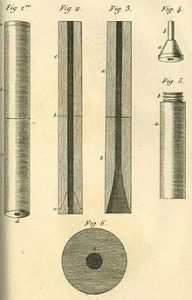 things like Tuberculosis can kill…he lived that nightmare with his mom. I am fairly certain that there were probably issues with her diagnosis too. After studying medicine, Laennec became a doctor. He also became a lecturer at the Collège de France in 1822 and professor of medicine in 1823. His final appointments were that of head of the medical clinic at the Hôpital de la Charité and professor at the Collège de France.
things like Tuberculosis can kill…he lived that nightmare with his mom. I am fairly certain that there were probably issues with her diagnosis too. After studying medicine, Laennec became a doctor. He also became a lecturer at the Collège de France in 1822 and professor of medicine in 1823. His final appointments were that of head of the medical clinic at the Hôpital de la Charité and professor at the Collège de France.
Laennec’s father was a lawyer, and he thought that being a doctor was a waste of René’s talents. With his father’s discouragement, René had a period of time during which he took long walks in the country, danced, studied Greek and wrote poetry. However, in 1799 he returned to study. Laennec studied medicine at the University of Paris under several famous physicians, including Dupuytren and Jean-Nicolas Corvisart-Desmarets. There he was trained to use sound as a diagnostic aid. Corvisart advocated the re-introduction of percussion during the French Revolution. In 1816, he was consulted by a young woman laboring under general symptoms of diseased heart, and in whose case percussion and the application of the hand were of little avail on account of the great degree of fatness. “The other method just mentioned [direct auscultation] being rendered inadmissible by the age and sex of the patient, I happened to recollect a simple and well-known fact, in acoustics…the great distinctness with which we hear the scratch of a pin at one end of a piece of wood on 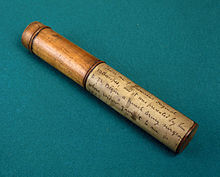 applying our ear to the other. Immediately, on this suggestion, I rolled a quire of paper into a kind of cylinder and applied one end of it to the region of the heart and the other to my ear, and was not a little surprised and pleased to find that I could thereby perceive the action of the heart in a manner much more clear and distinct than I had ever been able to do by the immediate application of my ear.” This situation started Laennec’s mind whirling, and before long, he had developed a simplistic version of what we now are all very familiar…the stethoscope. Ironically, like his mother, Laennec died of Tuberculosis on August 13, 1826. While I’m sure medicine had vastly improved during his lifetime, there was still no significant help for Tuberculosis.
applying our ear to the other. Immediately, on this suggestion, I rolled a quire of paper into a kind of cylinder and applied one end of it to the region of the heart and the other to my ear, and was not a little surprised and pleased to find that I could thereby perceive the action of the heart in a manner much more clear and distinct than I had ever been able to do by the immediate application of my ear.” This situation started Laennec’s mind whirling, and before long, he had developed a simplistic version of what we now are all very familiar…the stethoscope. Ironically, like his mother, Laennec died of Tuberculosis on August 13, 1826. While I’m sure medicine had vastly improved during his lifetime, there was still no significant help for Tuberculosis.
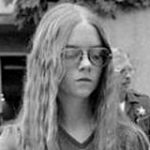 Unfortunately, these days, school shootings, while shocking every time, are not totally uncommon in this country. The reasons for the shootings vary, but are often blamed on bullying, loneliness, or anger for perceived wrongs. They never solve anything, least of all for the shooter, who is usually dead, or in prison after the heinous deed is done. The rest of the world is left wondering why, and how we can fix this. Of course, there are always the anti-gun advocates who say that the only solution is to take the guns out of the hands of the citizens, but as most sensible people know, guns don’t kill people, people kill people.
Unfortunately, these days, school shootings, while shocking every time, are not totally uncommon in this country. The reasons for the shootings vary, but are often blamed on bullying, loneliness, or anger for perceived wrongs. They never solve anything, least of all for the shooter, who is usually dead, or in prison after the heinous deed is done. The rest of the world is left wondering why, and how we can fix this. Of course, there are always the anti-gun advocates who say that the only solution is to take the guns out of the hands of the citizens, but as most sensible people know, guns don’t kill people, people kill people.
In 1979, I was a busy, young mother, when the first school shooting took place. The date was January 29, 1979. The place was Grover Cleveland Elementary School in San Diego, California. The shooter was 16 year old Brenda Spencer. I have to assume that she is some relation to me, as researchers have claimed that all the Spencers in the United States are related. That thought in itself makes me sad. People have the potential to become such great things, and there are so many wonderful things that a person could be the first to accomplish. So, why on that day, did young Brenda Spencer decide to take the lives of to men and wound nine children at the school across the street from her home. Her stated reasons were several…”I like red jackets,” “It livens up the day,” “I had no reason for it, and it was just fun,” “It was like shooting ducks in a pond,” “The children looked like a herd of cows standing around,” “It was really easy pickings,” And the one that stuck with the crime forever, “I just don’t like Mondays.” There is no good reason to decide to go out and kill people, but that last one stuck in my head. She didn’t like Mondays, so she ruined her own life, killed 2 men and wounded 9 children!!
Of course, I doubt if Mondays, red jackets, boredom, or animals had anything to do with it. In my opinion, the cause is mental illness. I’m not excusing her actions, because murder is a heinous crime. Brenda did not just wake up that day and decide to shoot up the school. She was a problem child, who was widely known as a drug abuser with a violent streak, such as repeatedly shooting BBs at the windows of the school. Still, her father gave her a .22 semi-automatic rifle and ammunition as a Christmas gift at the end of 1978. I’m sure he thought that her BB shooting was a harmless prank, but with the drugs and anger simmering inside her, he was wrong. She had started telling her classmates that she was going to do something “to get on TV.”
That January morning, as the children were entering the school, Brenda Spencer blazed away with rifle shots  from her home directly across the street from the school. After 20 minutes of shooting, police surrounded Spencer’s home for six hours before she surrendered. Brenda Spencer had become the first person to commit a school shooting. Asked for some explanation for the attack, she simply said, “I just don’t like Mondays. I did this because it’s a way to cheer up the day. Nobody likes Mondays.” Spencer’s hatred for the first day of the school week was later memorialized by Bob Geldof, the leader of the rock group The Boomtown Rats, in the song, “I Don’t Like Mondays.” Spencer, who pled guilty to two counts of murder and assault with a deadly weapon, is currently serving a term of 25 years to life at the California Institution for Women in Corona, California, and she was denied parole four times, most recently in 2005.
from her home directly across the street from the school. After 20 minutes of shooting, police surrounded Spencer’s home for six hours before she surrendered. Brenda Spencer had become the first person to commit a school shooting. Asked for some explanation for the attack, she simply said, “I just don’t like Mondays. I did this because it’s a way to cheer up the day. Nobody likes Mondays.” Spencer’s hatred for the first day of the school week was later memorialized by Bob Geldof, the leader of the rock group The Boomtown Rats, in the song, “I Don’t Like Mondays.” Spencer, who pled guilty to two counts of murder and assault with a deadly weapon, is currently serving a term of 25 years to life at the California Institution for Women in Corona, California, and she was denied parole four times, most recently in 2005.
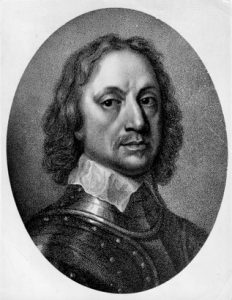 When people think of going into space, most of them think of the “Race to Space.” John F Kennedy (1917-1963) who served as the 35th President of the United States, was president during the Cuban Missile Crisis, the Civil Rights Movement, and the beginning of the United States involvement in the Vietnam War. The race to space was his pet project, but he was not the first person to think about it. I think you would be very surprised to find out who the first person to propose space travel.
When people think of going into space, most of them think of the “Race to Space.” John F Kennedy (1917-1963) who served as the 35th President of the United States, was president during the Cuban Missile Crisis, the Civil Rights Movement, and the beginning of the United States involvement in the Vietnam War. The race to space was his pet project, but he was not the first person to think about it. I think you would be very surprised to find out who the first person to propose space travel.
The first proposal for space travel in English history was made by Oliver Cromwell’s brother-in-law, John Wilkins 1614-1672) a theologian and natural philosopher, who married Cromwell’s youngest sister Robina. Wilkins was a polymath of great learning and curiosity, and would be one of the founders of the Royal Society. In two books he explored the possibility of “flying chariots” to carry men to the moon. He believed, as did many others, that the moon and planets were inhabited, and that we should meet these people and trade with them. People were anchored to the earth by a type of magnetism, and if it were possible to reach an altitude of just 20 miles, travellers would be free to fly, or rather sail, though space. Breathing wouldn’t be a problem as the astronauts would soon grow accustomed to the purer air breathed by angels. Of course, we now know that the problem with the “air” in space was the lack of it, not the purity of it.
Apparently, Wilkins experimented in building flying machines with Robert Hooke, in the gardens of Wadham 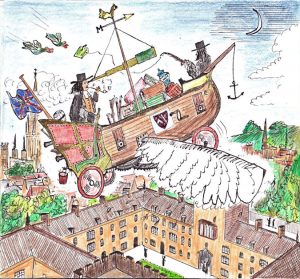 College, Oxford, in the 1650s. Some years later, however, with growing understanding of the nature of vacuums, he realised that space travel was much more complicated than he had first expected. I suppose it was a letdown in his philosophers mind, but the conclusion was inevitable, because as we all know space travel, while definitely possible, is not easy. It takes much scientific analysis and years of trial and error, but while it was not as easy as Wilkins thought it would be, he was on the right track after all. Nevertheless, Wilkins was not well known for his futuristic vision. While his Cromwellian connections reduced him to poverty after the return of the monarchy, Wilkins’s fortunes were gradually restored and he ended his life as Bishop of Chester.
College, Oxford, in the 1650s. Some years later, however, with growing understanding of the nature of vacuums, he realised that space travel was much more complicated than he had first expected. I suppose it was a letdown in his philosophers mind, but the conclusion was inevitable, because as we all know space travel, while definitely possible, is not easy. It takes much scientific analysis and years of trial and error, but while it was not as easy as Wilkins thought it would be, he was on the right track after all. Nevertheless, Wilkins was not well known for his futuristic vision. While his Cromwellian connections reduced him to poverty after the return of the monarchy, Wilkins’s fortunes were gradually restored and he ended his life as Bishop of Chester.

